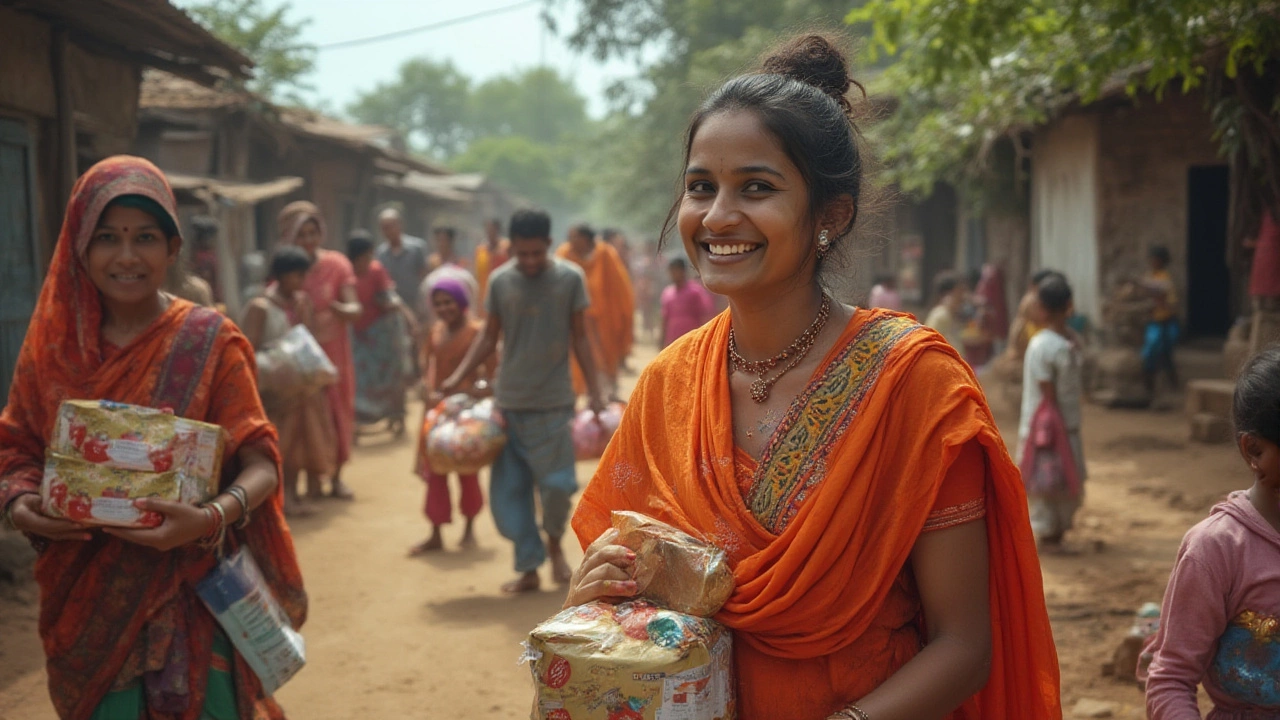
- Created by: Lydia Carmichael
- Completed on: 17 Jul 2025
- Categories: Charities
Ever wondered why people donate their time, money, or even their birthday gifts to charity? It's not just about being 'nice'—charity activities often decide if someone has a meal tonight, finds a warm bed, or even gets a second chance at life. Here’s something that might surprise you: in New Zealand alone, more than 27,000 registered charities operate as of mid-2025, making up a sizeable chunk of the social safety net. And according to Charities Services NZ, these organisations collectively handle billions in donations and grants every year. Maybe you picture a charity as just a soup kitchen or an op shop, but the scope is far wider and more creative than you’d guess.
What Counts as Charity Activities?
Charity work spans a crazy variety of activities, and it can be a little tricky to pin down what counts. At its heart, anything a charity does has to help people, animals, or the environment, and can’t just be about making money. Picture all the drama behind those annual fundraising runs, street-food markets for a cause, or book fairs to raise school money—these aren’t just ‘events’. Each one requires planning, volunteers, local permissions, insurance, supplies, and a bucketload of people skills. For big charities, activities zoom out far beyond what you see on the street. They manage budgets, develop partnerships with other nonprofits or businesses, lobby governments for policy change, and support scientific or education programs that may take years to show results.
Take a simple food bank as an example. There’s the obvious stuff: collecting groceries and packing hampers. But that’s the tip of the iceberg. Staff must organize supply chains, make sure food is safe, recruit and roster volunteers, analyze what’s needed by each family, and even teach cooking classes. Data-keeping is vital, too—donors want to know where their cans of baked beans go, and charities are legally required to account for every cent. In some cases, charities liaise with social workers, health care providers, or even IT developers to streamline their services.
Many charities tackle education, funding scholarships or sending mobile libraries out into rural areas. Some run hotlines for mental health—a ‘hidden’ activity making a measurable impact you won’t spot in public. In 2024, the Mental Health Foundation of New Zealand reported that over 85,000 people called their support line. Charities may educate people about legal rights, teach basic budgeting, hold job-readiness workshops, or provide clothes for job interviews. It’s not just handouts, but building skills or confidence, too.
And then you get charities focused on the environment. Tree planting, wildlife rescue, beach cleanups, and plastic-reduction campaigns are their bread and butter. Running these activities can involve training, certifications, environmental science know-how, and careful event management—especially with kids or when equipment like chainsaws or boats are involved. Some, like Forest & Bird, also publish research, work in endangered species breeding, or run advocacy campaigns to protect wilderness areas for decades to come.
Healthcare-focused charities arrange for patient support groups, arrange transport to hospital, or fund research into rare diseases. Some fund fellowships for young doctors, run rehab classes for injury survivors, or send out medical kits after cyclones. They might have trusted relationships with hospitals, and often have to vet applications for aid, keep up with brutal regulatory requirements, or coordinate dozens of volunteers with deep sensitivity, especially when dealing with sick or bereaved families.

Fundraising and Community Outreach: The Engine Room
If you’ve ever rattled a collection bucket at a sausage sizzle or sponsored a friend to do a half-marathon, you’ve been part of a charity’s work. Fundraising isn’t just about getting cash—it’s about connecting with people, building trust, and telling a story strong enough to make you care. For some charities, fundraising is a year-round grind: coming up with new campaign ideas, testing digital ads, meeting with major donors, or navigating complicated grant applications. The Children’s Hospital Foundation, as a real-world example, said in 2024 that just their annual gala dinner raised over $1.2 million NZD, but it required a team of 30 people, months of planning, and hundreds of volunteers on the night.
Charities need to build community connections all the time. This includes education nights, meet-and-greets, info stands at markets, or school visits. Many host socials or appreciation gatherings for their volunteers. Some get creative: there are yarn-bombing projects where the ‘activity’ is decorating public spaces in bright knitted creations to highlight loneliness. Others host debates or film screenings about their cause. Community outreach also involves digital engagement: social media, newsletters, and webinars connect with younger audiences. During the 2020s lockdowns, many charities pivoted to live streams and online events, which remain popular for people who can’t leave their houses easily.
Measuring impact is huge. Grants and donors expect evidence—so charities track the number of people helped, meals served, trees planted, or legal consultations given. Here’s how charity activities break down by main category in New Zealand, using 2025 stats:
| Type of Activity | Avg. Annual Activities (NZ, 2025) | People Reached |
|---|---|---|
| Food aid / meal services | 35,000+ deliveries | 300,000+ |
| Healthcare support | 18,000+ sessions | 100,000+ |
| Youth programs | 12,500+ events | 90,000+ |
| Environmental efforts | 2,000+ events | 55,000+ |
Public advocacy is also on the list. When a charity campaigns to change a law, raise awareness, or get government funding increased, that’s a core activity. One example? The Wellington Homeless Women's Trust pushed for zoning law tweaks to allow safe emergency housing, which succeeded after two years of lobbying in 2024. Sometimes advocacy is teaching people to advocate for themselves—like immigrant support agencies running workshops on workplace rights.
Don't forget about the little but vital things: sorting donations, stocking op shops, stuffing envelopes, translating materials, or baking for a cake stall. “The magic of charity work is you rarely know the true impact,” says Nicki Wilson, CEO of Volunteer Wellington.
“One act of kindness tends to ripple out in ways we can never fully measure.”Even the routine jobs—changing lightbulbs in a shelter, answering email queries, updating a spreadsheet—add up to tangible good in the community. That’s why so many people come back week after week.

Behind the Scenes: How Charities Keep Activities Going
If it all sounds a bit overwhelming, that's because running a charity truly is a juggling act. Every activity, from a morning drop-in for rough sleepers to a national online education campaign, relies on a network of back-end systems and compliance checks. No charity can run on good intentions alone: there’s loads happening behind closed doors. For a registered charity in New Zealand, a big slice of the work is compliance—annual financial reports, audits, child safety checks, risk assessments, and trustee reviews are all legal musts.
Volunteers are the lifeblood. Stats NZ’s 2024 report shows over 1.2 million Kiwis volunteered for charities, giving an estimated 157 million hours each year. That’s equivalent to every person in Wellington volunteering full-time for five weeks. But volunteers need recruiting, screening, training, and thanking. Staff often have to manage rosters, cover for no-shows, and keep things legal and safe—especially with children or vulnerable adults. Some charities now offer regular training workshops for volunteers on everything from trauma awareness to food safety and bullying prevention, helping both service quality and volunteer retention.
Innovation is creeping in. Some charities now use AI to match food donations to households, analyze the success of events, or even predict the spread of homelessness in major urban areas for targeted relief. Others started ‘social enterprises’—op shops, cafes, or vintage stores whose profits fund essential programs. It’s not just about survival, but staying relevant and effective as needs and communities change. In 2023, The Good Karma Project in Auckland partnered with a local university to develop a simple app that tracks surplus food from supermarkets in real time and redirects it to nearby shelters. That tech saved tons from landfill within months of launch.
There are also challenges. Charities juggle donor expectations with practical needs—do you spend $10,000 on a flash fundraising video, or use the money on rent for the drop-in centre? Scandals in the sector can erode trust, so transparency is at a premium. Many small charities now publish monthly breakdowns of income and spending, or regular "impact stories" showing exactly how donations are used. And there’s more demand than ever before: as government funding tightens, charities fill bigger gaps.
If you’re thinking about jumping in, there are heaps of ways to get involved—organise a workplace drive, pick a charity close to your heart, or simply ask your local op shop if they need a hand. The diversity of charity activities means there’s a role for nearly any skill set from accounting to singing with preschoolers to fixing computers. As the legendary Dame Whina Cooper once said,
“Take care of our people and our land, and you take care of the future.”That spirit sits at the heart of every good charity activity, big or small.